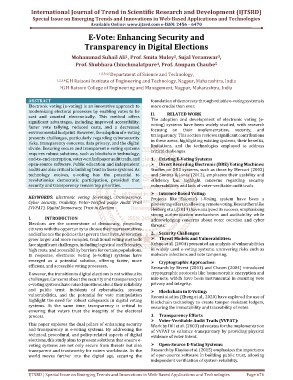Page 686 - Emerging Trends and Innovations in Web-Based Applications and Technologies
P. 686
International Journal of Trend in Scientific Research and Development (IJTSRD)
Special Issue on Emerging Trends and Innovations in Web-Based Applications and Technologies
Available Online: www.ijtsrd.com e-ISSN: 2456 – 6470
E-Vote: Enhancing Security and
Transparency in Digital Elections
2
1
3
Mohammad Suhail Ali , Prof. Smita Muley , Sujal Yeramwar ,
4
Prof. Shubhara Chinchmalatpure , Prof. Anupam Chaube
5
1,2,3,4,5 Department of Science and Technology,
1,2,3,4 G H Raisoni Institute of Engineering and Technology, Nagpur, Maharashtra, India
5 G H Raisoni College of Engineering and Management, Nagpur, Maharashtra, India
ABSTRACT foundation of democracy through reliable e-voting systems is
Electronic voting (e-voting) is an innovative approach to more crucial than ever.
modernizing electoral processes by enabling votes to be II.
cast and counted electronically. This method offers RELATED WORK
The adoption and development of electronic voting (e-
significant advantages, including improved accessibility,
faster vote tallying, reduced costs, and a decreased voting) systems have been widely studied, with research
focusing on their implementation, security, and
environmental footprint. However, the adoption of e-voting
transparency. This section reviews significant contributions
presents challenges, particularly regarding cybersecurity
in these areas, highlighting existing systems, their benefits,
risks, transparency concerns, data privacy, and the digital
limitations, and the technologies employed to address
divide. Ensuring secure and transparent e-voting systems
critical challenges.
requires robust solutions, such as blockchain technology,
end-to-end encryption, voter-verified paper audit trails, and 1. Existing E-Voting Systems
open-source software. Public education and independent Direct Recording Electronic (DRE) Voting Machines:
audits are also critical to building trust in these systems. As Studies on DRE systems, such as those by Mercuri (2002)
technology evolves, e-voting has the potential to and Simons & Jones (2012), emphasize their usability and
revolutionize democratic participation, provided that efficiency but highlight concerns regarding security
security and transparency remain top priorities. vulnerabilities and lack of voter-verifiable audit trails.
Internet-Based Voting:
KEYWORDS: Electronic voting (e-voting), Transparency, Projects like Estonia’s i-Voting system have been a
Cyber security, Usability, Voter-Verified paper Audit Trail pioneering effort in allowing remote voting. Researchers like
(VVPAT), Digital Democracy, Trust in Election Heiberg et al. (2014) have analyzed its success, emphasizing
strong authentication mechanisms and auditability while
I. INTRODUCTION acknowledging concerns about voter coercion and cyber
Elections are the cornerstone of democracy, providing
threats.
citizens with the opportunity to choose their representatives
and influence the policies that govern their lives. As societies 2. Security Challenges
grow larger and more complex, traditional voting methods Threat Models and Vulnerabilities:
face significant challenges, including logistical inefficiencies, Kohno et al. (2004) presented an analysis of vulnerabilities
high costs, and accessibility barriers for certain populations. in widely used e-voting systems, uncovering risks such as
In response, electronic voting (e-voting) systems have malware infections and vote tampering.
emerged as a potential solution, offering faster, more
Cryptographic Approaches:
efficient, and accessible voting processes.
Research by Rivest (2001) and Chaum (2004) introduced
However, the transition to digital elections is not without its cryptographic protocols like homomorphic encryption and
challenges. Concerns about the security and transparency of mix-nets, which have been instrumental in ensuring vote
e-voting systems have raised questions about their reliability privacy and integrity.
and public trust. Incidents of cyberattacks, system Blockchain in E-Voting:
vulnerabilities, and the potential for vote manipulation Recent studies (Zheng et al., 2020) have explored the use of
highlight the need for robust safeguards in digital voting blockchain technology to create tamper-resistant ledgers,
systems. At the same time, transparency is critical to ensuring the immutability and traceability of votes.
ensuring that voters trust the integrity of the electoral
process. 3. Transparency Efforts
Voter-Verifiable Audit Trails (VVPAT):
This paper explores the dual pillars of enhancing security Work by Dill et al. (2003) advocates for the implementation
and transparency in e-voting systems. By addressing the of VVPAT to enhance transparency by providing physical
technical, procedural, and policy-related aspects of digital evidence of voter intent.
elections, this study aims to present solutions that ensure e-
voting systems are not only secure from threats but also Open-Source E-Voting Systems:
transparent and trustworthy for voters worldwide. As the Research by Kiayias et al. (2015) emphasizes the importance
world moves further into the digital age, securing the of open-source software in building public trust, allowing
independent verification of system reliability.
IJTSRD | Special Issue on Emerging Trends and Innovations in Web-Based Applications and Technologies Page 676

